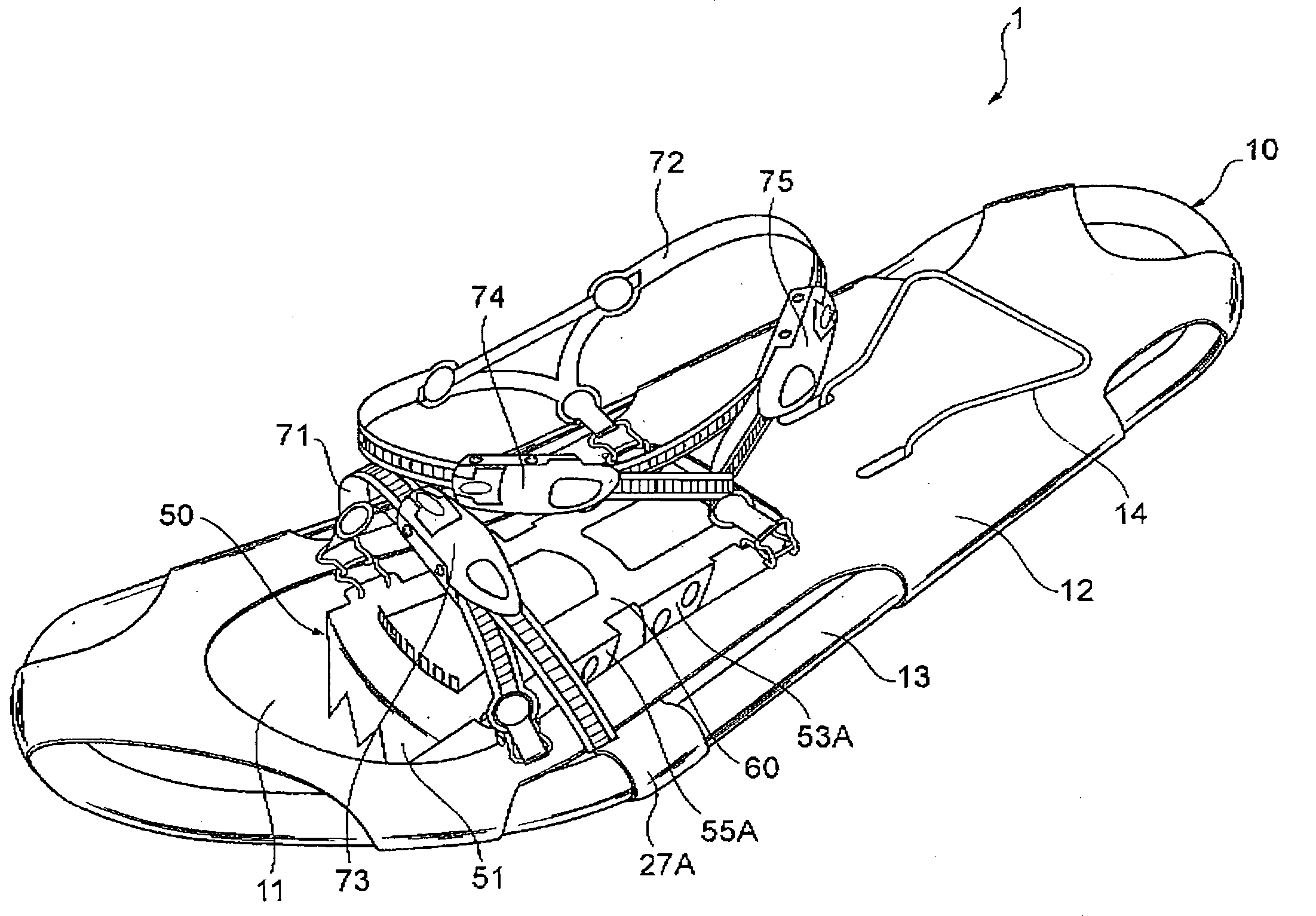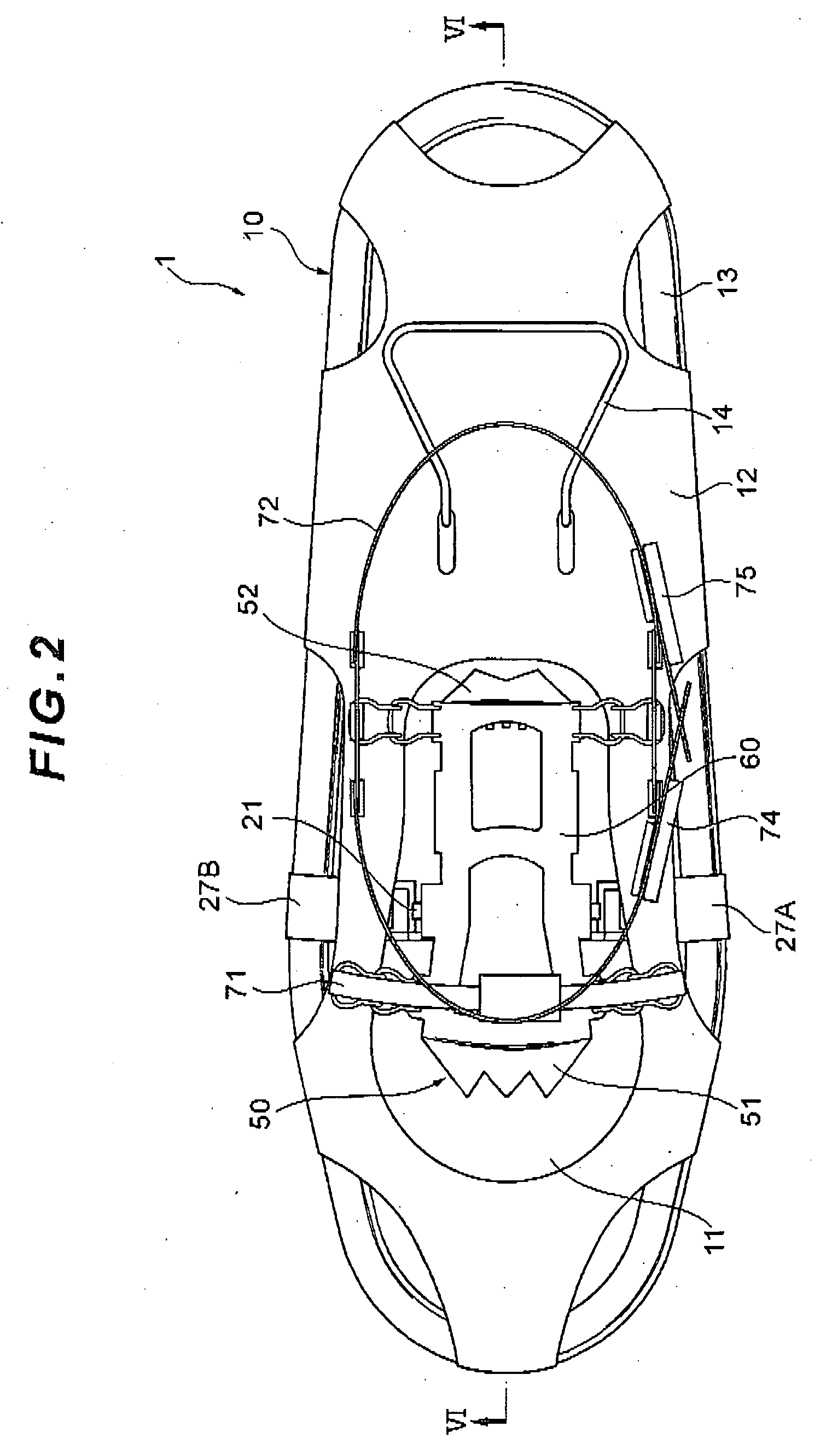[0014]Also, the snowshoe with crampons according to an aspect of this invention can be configured so that the snowshoe body has a spindle extending in a generally-horizontal direction relative to a widthwise direction of the snowshoe body and being placed across the opening and supports the attachable member so that the attachable member can rotate around the spindle; and the spindle includes second engaging members for engaging with the first engaging members so that the first engaging members can rotate around the second engaging members and be attached to or detached from the second engaging members. With the snowshoe with crampons having the above-described configuration, the attachable member can rotate around the spindle as a fulcrum point,
clockwise or counterclockwise as seen with the
toe side of the snowshoe body on the left. With the snowshoe with crampons according to this aspect of the invention, the opening in which the attachable member is located is formed in an area where the
toe side of footgear will be positioned when the footgear is attached to the snowshoe with crampons. Therefore, the
heel side of the footgear will be positioned on the rear side closer to the rear end of the snowshoe body than the opening. As a result, in addition to the advantageous effects mentioned above, when the footgear is attached to the snowshoe with crampons, the wearer can walk stably without letting the attachable member rotate
clockwise (as seen with the toe side of the snowshoe body on the left) more than necessary (i.e., without letting the attachable member rotate to allow the
heel side of the attachable member to move closer to the ground more than necessary.
[0015]Moreover, with the snowshoe with crampons according to an aspect of this invention, a stopper for preventing the attachable member from rotating more than the specified angle counterclockwise as seen with the toe side of the snowshoe body on the left can be placed on the snowshoe body. Because of this configuration, in addition to the advantageous effects mentioned above, when the footgear is attached to the snowshoe with crampons, the wearer can walk more stably without letting the attachable member rotate counterclockwise (as seen with the toe side of the snowshoe body on the left) more than necessary (i.e., without letting the attachable member rotate to allow the toe side of the attachable member to move closer to the ground more than necessary. It is also possible to prevent the attachable member from rotating too much and the top end of the attachable member from hitting the wear's shin.
[0016]Furthermore, the snowshoe with crampons according to an aspect of this invention can be configured so that when the attachable member has been rotated a specified angle
clockwise as seen with the toe side of the snowshoe body on the left, the engagement between the first engaging members and the second engaging members can be released. Because of this configuration, when the footgear is attached to the snowshoe with crampons, in addition to the aforementioned advantageous effects, the attachable member will not be removed from the snowshoe body and it is possible to prevent the attachable member from suddenly coming off the snowshoe body. Also, the snowshoe with crampons having the above-described configuration can also be configured so that each of the first engaging members has a support hole for supporting the spindle so that it can rotate, and a
cut formed as a passage to the support hole; and each of the second engaging members is of a generally-oval cross-sectional shape as taken generally perpendicular to its axial direction, and a
minor axis of the generally-oval shape is shorter than a minimum value of the distance between the second engaging member and a side wall of the first engaging member defining the
cut; and wherein when the attachable member has been rotated a specified angle clockwise as seen with the toe side of the snowshoe body on the left, the
minor axis of the generally-oval shape is positioned in generally parallel with the side wall surface defining the
cut, and each of the second engaging members is removed through the cut from the support hole, thereby releasing the engagement.
[0017]The snowshoe with crampons according to an aspect of this invention can also be configured so that a fastening member for fastening the footgear to the snowshoe with crampons is placed on one surface of the attachable member where the footgear is to be attached. Because of this configuration, when the attachable member is removed from the snowshoe body, the fastening member for fastening the footgear will also be removed together with the attachable member. Therefore, the right-foot snowshoe body and the left-foot snowshoe body can be carried around or stored compactly without the problem of bulkiness. Also, attachable members removed from a snowshoe body can be used independently as climbing irons.
[0018]Furthermore, the first engaging members can be formed as crampons protruding in directions generally toward the ground from one surface of the attachable member opposite the other surface where the footgear is to be attached.
[0019]Since with the snowshoe with crampons according to an aspect of the invention, the attachable member equipped with the crampons can be removed from the snowshoe body, the snowshoe body can be carried around or stored compactly without the problem of bulkiness. As a result, if a person glides (for example, skis) while carrying the right-foot snowshoe body and the left-foot snowshoe body placed one over the other, it is easier for the person to glide without being bothered by bulky baggage. Also, the weight of the snowshoe with crampons can be distributed by removing the attachable member from the snowshoe body. Therefore, when a person glides (for example, skis) while carrying the snowshoes with crampons, it is possible to prevent, for example, the influence of
centrifugal force and enhance the sense of stability when gliding. Also, removed attachable members can be used independently as climbing irons. As a result, it is unnecessary to separately carry the climbing irons in addition to the snowshoes with crampons, which is convenient.
 Login to View More
Login to View More  Login to View More
Login to View More 


